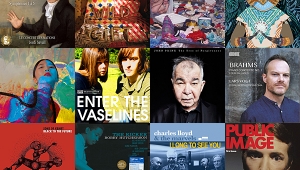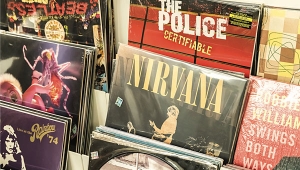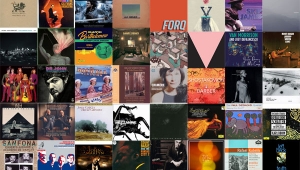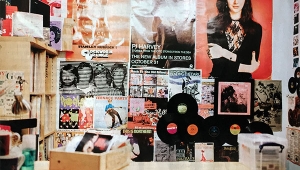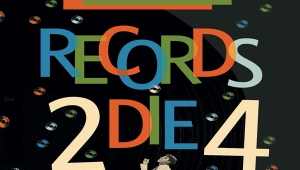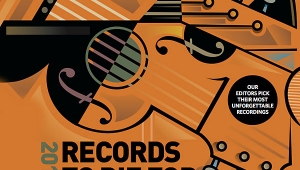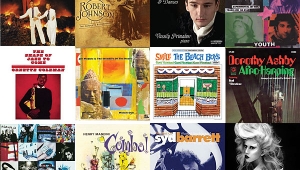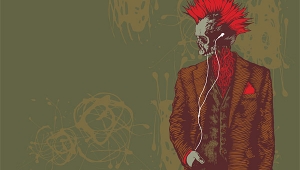| Columns Retired Columns & Blogs |
2005 Records To Die For Page 5
BOB GULLA
BOB MARLEY AND THE WAILERS: Burnin' (Deluxe Edition)
Tuff Gong/Island 3359 (CD). 1973/2004. Chris Blackwell, Wailers, prods.; Sylvan Morris, eng. AAD? TT: 2:15:33
Made just six months after their first masterpiece, Catch a Fire, Burnin' is simply brilliant reggae, and arguably the Wailers' very best disc. Like every great (the adjective is not used loosely) album, this one succeeds on many levels, from its anthemic militancy to its sparkling melodies and rich performances. The call to arms here may at first seem at odds with the Wailers' usual irie vibes. But it's this urgency in, for examples, "Burnin' and Lootin' " and "I Shot the Sheriff," that injects these melodies with impact and soulful potency.
SWEET SOUL MUSIC: Voices from the Shadows
Percy Sledge, O.V. Wright, Aretha Franklin, George Perkins and the Silver Stars, Laura Lee, Soul Brothers Six, Arthur Alexander, Otis Clay, The Invincibles, James Carr, Eddie Giles, The Enchanters, Solomon Burke, Judy Clay, Don Covay and the Good Timers
Warner Bros. 26731-2 (CD). 1992. Jerry Wexler, Chips Moman, Dan Penn, Jerry Ragavoy, etc., prods.; various engs. AAD. TT: 45:55
While it doesn't compare in breadth to the hefty soul revues from the Ace family of import labels, Sweet Soul Music, a listening companion to Peter Guralnick's fine book of the same title, is one of the very best, true-blue soul compilations available domestically. Among its 15 tracks, a handful of the genre's most sublime talents—Arthur Alexander, James Carr, and Solomon Burke—get a chance to belt it out. And there's nothing sweeter to these ears than the warm analog thump of a soulful rhythm section.
CHÖYING DROLMA & STEVE TIBBETTS: Selwa
Chöying Drolma, voice; Steve Tibbetts, Marc Anderson, all instruments; Lodro Sangmo, Sherab Palmo, additional voices
Six Degrees 857036 1104-2 (CD). 2004. Lee Townsend, prod.; Steve Tibbetts, Marc Anderson, engs. DDD. TT: 46:35
Steve Tibbetts spends his time carefully assembling sonic landscapes that transcend the notion of a particular place or time. This release is his second collaboration with Tibetan nun and vocalist Chöying Drolma, whom he recorded remotely in Boudhanath, Nepal, then brought the computer files back home to Minnesota, where he wrapped them with his and Marc Anderson's trademark skins of ambient guitar and percussion. Tibbetts lends a great ear to all of his projects. Consider lending him yours.
WWW.TECHWEBSOUND.COM
Every 1960s psychedelic musician-engineer-producer ever known to inner space. (iTunes, RealPlayer, etc.). AAAD. 56kbps. TT: On to Infinity...
For R2D4 No.2, please allow me to bend the rules a tad and recognize the one resource that inspired more music appreciation than anything else in 2004: www.techwebsound.com. A blinkin' website?!? Yup. The abovementioned URL is home to the Technicolor Web of Sound Internet radio station. Not only is www.techwebsound.com probably the one thing these ears listened to most last year, but it's responsible for literally hundreds of recent disc purchases. (Wait—I'm finding free music online, yet buying more as a result? That's not how it's supposed to work!) There are thousands of Web radio stations broadcasting anything that makes noise, and my "anything" is '60s psychedelic rock music. It's not all good, and the sound quality sucks big time, but I can't turn away. And it's free. The closest thing out there to my beloved ca-1960s KSAN. Find a Web station that you like, then hold on to your wallet.
BILLY MAY & HIS ORCHESTRA: The Girls and Boys On Broadway
Capitol T1418 (mono LP). 1960. Dave Cavanaugh, Tom Morgan, prods. AAA.
Keen collectors will note from the catalog number above that this isn't even stereo. But the post-WWII remnants of what once was called "big band" continue to yield surprises, and this gorgeous LP of Broadway tunes arranged by one of the all-time greats is full of them. Not least is its ability to make people forget that they're listening to mono. Play it for friends without telling them—see how few actually notice. Go straight to, say, "Guys and Dolls" and watch their faces: bass, dynamics, a sense of air to rival Casino Royale. And the performance? It swings.
DAVE CLARK FIVE: The Best of the Dave Clark Five
Regal/Starline/EMI SRS5037 (LP). 1970. Dave Clark, Adrian Clark, prods. AAA.
Two remarkable details about this, especially when you consider that liking the DC5 is cause for humiliation. First, this is an obscure, UK-only budget-label pressing. Second, I'm recommending it for one track. According to my sources, this is the only way you can get a true stereo version of "Glad All Over" (the possible alternative is ever-rarer jukebox EPs). Why would I want you to spend all that on one track? Because it has lower registers and impact in league with The Sheffield Track Record. Once they've discovered it, the Bass'n'Drums crowd will sample it to death. Oh, and it's a killer song, regardless of your hipness quotient.
GRECHANINOV: Songs of Grechaninov
Georgine Resick, soprano; Warren Jones, piano
Bridge 9142 (CD). 1996/2004. Judith Sherman, prod., eng.; David & Becky Starobin, exec. prods. DDD. TT: 64:43
Whether you delight in classical recital singing or find the category intimidating, this CD is likely to enchant you. With many of its selections for children, about children, or on childlike themes, with its swirling snowflakes and meowing cat, it radiates charm. The Russian composer Alexander Grechaninov (1864–1956) masterfully depicted text. For their part, Resick and Jones perform superbly, presenting this melodious bouquet of songs in full bloom. The pair actually recorded them eight years ago for a label that expired before a CD could be issued. Happily, Bridge principals David and Becky Starobin don't suffer from the not-invented-here syndrome.
JESSIE MAE HEMPHILL: Get Right Blues
Jessie Mae Hemphill, vocals, guitar, diddley bow, tambourine, ankle bells, hat box, bass drum, snare drum; David Evans, guitar; Compton Jones, vocal, diddley bow, tambourine, hat box; Glen Faulkner, diddley bow; Lois Brown, bass; Joe Hicks, drums; Napoleon Strickland, vocal; Bettye Mitchell, tambourine
Inside Sounds ISC-0519 (CD). 1979–1985/2003. David Evans, prod., eng.; Eddie Dattel, exec. prod. ADD. TT: 51:31
This earthy, northern-Mississippi hill-country artist learned music from her grandfather, Sid Hemphill, the folk virtuoso Alan Lomax called his "main find." Well past 40 before recording commercially, she earned three W.C. Handy Awards for singing her own blues tunes while accompanying herself on electric guitar. Jessie Mae Hemphill could hypnotize listeners with the short, repeated riffs characteristic of her locale, until a stroke curtailed her career in 1993. She still sings sanctified songs, and this CD combines a few of them with some of her finest blues. Certain tracks echo the black fife-and-drum tradition that blends American Colonial militia music with African-American strains, and her occasional use of ankle bells honors her family's Choctaw branch. Hemphill is as authentic as musicians get in her pocket of the South, the place Lomax called "the land where the blues began."
BRAHMS: Works for Solo Piano
Julius Katchen, piano
London 455 247-2 (6 CDs). 1962–65/1997. Ray Minshull, prod.; Kenneth Wilkinson, eng. ADD. TT: 6:27:47
These recordings were originally released on LP in the mid-1960s. Julius Katchen, perhaps the greatest interpreter of Brahms in living memory, died a few years later, before his 50th birthday. These performances are by turns intimate and large-scaled without ever losing track of the smallest detail, as astonishingly precise as they are overwhelmingly powerful and unfailingly musical. Each work is taken purely on its own terms. Listening to these discs, I cannot tell which impresses me more: the genius and variety of Brahms or the penetrating passion of Katchen's intelligence, which matches Brahms at every point. The tempos may be a bit fast for some (Op.79!), but Katchen never loses control or slights the works in any way. London's famous ffss piano sound is big, close, and a bit harsh, with all the blackness, richness, and astringency of unsweetened chocolate—but I've been listening to these performances for 40 years and have wearied of the sound no more than I have of the music or of Katchen.
YSAŸE: Six Sonatas for Violin Solo, Op.27
Thomas Zehetmair, violin
ECM New Series 1835 (CD). 2004. Manfred Eicher, prod.; Stephan Schellmann, eng. DDD. TT: 65:55
It has taken most of a century for these sonatas by the Belgian virtuoso and composer Eugène Ysaÿe to establish themselves in the standard repertoire, but they stand shoulder to shoulder with J.S. Bach's solo Partitas and Sonatas (one of which Ysaÿe quotes here, to hilarious and unnervingly postmodern effect). Ysaÿe's wit is searing, his passion white-hot, and his ability to imply multiple voices, times, and harmonies with a (mostly) non-chording instrument is at least the equal of Bach's. Thomas Zehetmair tears into these works with what sounds like barely contained fury, an edge almost desperate, and with absolute control. He sounds as if he is playing for his life; I can't help but think that, at the end of these sessions, the floor was littered with pieces of his violin. The disc was recorded in a small Austrian church, but the acoustic is that of the cathedral of the mind, the center of which is everywhere, the circumference nowhere. The music, these performances, and this recording are as intimate as thought and just as spacious as that greatest of all indoors. Do not miss this.
BOB MARLEY AND THE WAILERS: Burnin' (Deluxe Edition)
Tuff Gong/Island 3359 (CD). 1973/2004. Chris Blackwell, Wailers, prods.; Sylvan Morris, eng. AAD? TT: 2:15:33
Made just six months after their first masterpiece, Catch a Fire, Burnin' is simply brilliant reggae, and arguably the Wailers' very best disc. Like every great (the adjective is not used loosely) album, this one succeeds on many levels, from its anthemic militancy to its sparkling melodies and rich performances. The call to arms here may at first seem at odds with the Wailers' usual irie vibes. But it's this urgency in, for examples, "Burnin' and Lootin' " and "I Shot the Sheriff," that injects these melodies with impact and soulful potency.
SWEET SOUL MUSIC: Voices from the Shadows
Percy Sledge, O.V. Wright, Aretha Franklin, George Perkins and the Silver Stars, Laura Lee, Soul Brothers Six, Arthur Alexander, Otis Clay, The Invincibles, James Carr, Eddie Giles, The Enchanters, Solomon Burke, Judy Clay, Don Covay and the Good Timers
Warner Bros. 26731-2 (CD). 1992. Jerry Wexler, Chips Moman, Dan Penn, Jerry Ragavoy, etc., prods.; various engs. AAD. TT: 45:55
While it doesn't compare in breadth to the hefty soul revues from the Ace family of import labels, Sweet Soul Music, a listening companion to Peter Guralnick's fine book of the same title, is one of the very best, true-blue soul compilations available domestically. Among its 15 tracks, a handful of the genre's most sublime talents—Arthur Alexander, James Carr, and Solomon Burke—get a chance to belt it out. And there's nothing sweeter to these ears than the warm analog thump of a soulful rhythm section.
JON IVERSON
CHÖYING DROLMA & STEVE TIBBETTS: Selwa
Chöying Drolma, voice; Steve Tibbetts, Marc Anderson, all instruments; Lodro Sangmo, Sherab Palmo, additional voices
Six Degrees 857036 1104-2 (CD). 2004. Lee Townsend, prod.; Steve Tibbetts, Marc Anderson, engs. DDD. TT: 46:35
Steve Tibbetts spends his time carefully assembling sonic landscapes that transcend the notion of a particular place or time. This release is his second collaboration with Tibetan nun and vocalist Chöying Drolma, whom he recorded remotely in Boudhanath, Nepal, then brought the computer files back home to Minnesota, where he wrapped them with his and Marc Anderson's trademark skins of ambient guitar and percussion. Tibbetts lends a great ear to all of his projects. Consider lending him yours.
WWW.TECHWEBSOUND.COM
Every 1960s psychedelic musician-engineer-producer ever known to inner space. (iTunes, RealPlayer, etc.). AAAD. 56kbps. TT: On to Infinity...
For R2D4 No.2, please allow me to bend the rules a tad and recognize the one resource that inspired more music appreciation than anything else in 2004: www.techwebsound.com. A blinkin' website?!? Yup. The abovementioned URL is home to the Technicolor Web of Sound Internet radio station. Not only is www.techwebsound.com probably the one thing these ears listened to most last year, but it's responsible for literally hundreds of recent disc purchases. (Wait—I'm finding free music online, yet buying more as a result? That's not how it's supposed to work!) There are thousands of Web radio stations broadcasting anything that makes noise, and my "anything" is '60s psychedelic rock music. It's not all good, and the sound quality sucks big time, but I can't turn away. And it's free. The closest thing out there to my beloved ca-1960s KSAN. Find a Web station that you like, then hold on to your wallet.
KEN KESSLER
BILLY MAY & HIS ORCHESTRA: The Girls and Boys On Broadway
Capitol T1418 (mono LP). 1960. Dave Cavanaugh, Tom Morgan, prods. AAA.
Keen collectors will note from the catalog number above that this isn't even stereo. But the post-WWII remnants of what once was called "big band" continue to yield surprises, and this gorgeous LP of Broadway tunes arranged by one of the all-time greats is full of them. Not least is its ability to make people forget that they're listening to mono. Play it for friends without telling them—see how few actually notice. Go straight to, say, "Guys and Dolls" and watch their faces: bass, dynamics, a sense of air to rival Casino Royale. And the performance? It swings.
DAVE CLARK FIVE: The Best of the Dave Clark Five
Regal/Starline/EMI SRS5037 (LP). 1970. Dave Clark, Adrian Clark, prods. AAA.
Two remarkable details about this, especially when you consider that liking the DC5 is cause for humiliation. First, this is an obscure, UK-only budget-label pressing. Second, I'm recommending it for one track. According to my sources, this is the only way you can get a true stereo version of "Glad All Over" (the possible alternative is ever-rarer jukebox EPs). Why would I want you to spend all that on one track? Because it has lower registers and impact in league with The Sheffield Track Record. Once they've discovered it, the Bass'n'Drums crowd will sample it to death. Oh, and it's a killer song, regardless of your hipness quotient.
DAVID LANDER
GRECHANINOV: Songs of Grechaninov
Georgine Resick, soprano; Warren Jones, piano
Bridge 9142 (CD). 1996/2004. Judith Sherman, prod., eng.; David & Becky Starobin, exec. prods. DDD. TT: 64:43
Whether you delight in classical recital singing or find the category intimidating, this CD is likely to enchant you. With many of its selections for children, about children, or on childlike themes, with its swirling snowflakes and meowing cat, it radiates charm. The Russian composer Alexander Grechaninov (1864–1956) masterfully depicted text. For their part, Resick and Jones perform superbly, presenting this melodious bouquet of songs in full bloom. The pair actually recorded them eight years ago for a label that expired before a CD could be issued. Happily, Bridge principals David and Becky Starobin don't suffer from the not-invented-here syndrome.
JESSIE MAE HEMPHILL: Get Right Blues
Jessie Mae Hemphill, vocals, guitar, diddley bow, tambourine, ankle bells, hat box, bass drum, snare drum; David Evans, guitar; Compton Jones, vocal, diddley bow, tambourine, hat box; Glen Faulkner, diddley bow; Lois Brown, bass; Joe Hicks, drums; Napoleon Strickland, vocal; Bettye Mitchell, tambourine
Inside Sounds ISC-0519 (CD). 1979–1985/2003. David Evans, prod., eng.; Eddie Dattel, exec. prod. ADD. TT: 51:31
This earthy, northern-Mississippi hill-country artist learned music from her grandfather, Sid Hemphill, the folk virtuoso Alan Lomax called his "main find." Well past 40 before recording commercially, she earned three W.C. Handy Awards for singing her own blues tunes while accompanying herself on electric guitar. Jessie Mae Hemphill could hypnotize listeners with the short, repeated riffs characteristic of her locale, until a stroke curtailed her career in 1993. She still sings sanctified songs, and this CD combines a few of them with some of her finest blues. Certain tracks echo the black fife-and-drum tradition that blends American Colonial militia music with African-American strains, and her occasional use of ankle bells honors her family's Choctaw branch. Hemphill is as authentic as musicians get in her pocket of the South, the place Lomax called "the land where the blues began."
RICHARD LEHNERT
BRAHMS: Works for Solo Piano
Julius Katchen, piano
London 455 247-2 (6 CDs). 1962–65/1997. Ray Minshull, prod.; Kenneth Wilkinson, eng. ADD. TT: 6:27:47
These recordings were originally released on LP in the mid-1960s. Julius Katchen, perhaps the greatest interpreter of Brahms in living memory, died a few years later, before his 50th birthday. These performances are by turns intimate and large-scaled without ever losing track of the smallest detail, as astonishingly precise as they are overwhelmingly powerful and unfailingly musical. Each work is taken purely on its own terms. Listening to these discs, I cannot tell which impresses me more: the genius and variety of Brahms or the penetrating passion of Katchen's intelligence, which matches Brahms at every point. The tempos may be a bit fast for some (Op.79!), but Katchen never loses control or slights the works in any way. London's famous ffss piano sound is big, close, and a bit harsh, with all the blackness, richness, and astringency of unsweetened chocolate—but I've been listening to these performances for 40 years and have wearied of the sound no more than I have of the music or of Katchen.
YSAŸE: Six Sonatas for Violin Solo, Op.27
Thomas Zehetmair, violin
ECM New Series 1835 (CD). 2004. Manfred Eicher, prod.; Stephan Schellmann, eng. DDD. TT: 65:55
It has taken most of a century for these sonatas by the Belgian virtuoso and composer Eugène Ysaÿe to establish themselves in the standard repertoire, but they stand shoulder to shoulder with J.S. Bach's solo Partitas and Sonatas (one of which Ysaÿe quotes here, to hilarious and unnervingly postmodern effect). Ysaÿe's wit is searing, his passion white-hot, and his ability to imply multiple voices, times, and harmonies with a (mostly) non-chording instrument is at least the equal of Bach's. Thomas Zehetmair tears into these works with what sounds like barely contained fury, an edge almost desperate, and with absolute control. He sounds as if he is playing for his life; I can't help but think that, at the end of these sessions, the floor was littered with pieces of his violin. The disc was recorded in a small Austrian church, but the acoustic is that of the cathedral of the mind, the center of which is everywhere, the circumference nowhere. The music, these performances, and this recording are as intimate as thought and just as spacious as that greatest of all indoors. Do not miss this.
- Log in or register to post comments

